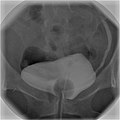Cystography
Cystography is a diagnostic imaging test used to examine the structure and functionality of the bladder and the urethra. This procedure is particularly useful in identifying abnormalities such as bladder stones, tumors, diverticula, and vesicoureteral reflux. It involves the use of X-ray imaging and a contrast material to visualize the bladder's interior.
Procedure[edit]
Cystography is typically performed in a hospital's radiology department. The process begins with the patient lying on their back on an X-ray table. A healthcare professional then inserts a catheter into the urethra, through which a contrast dye is introduced into the bladder. The contrast dye makes the bladder area more visible on the X-ray images. Once the bladder is filled with the dye, the catheter is removed, and several X-rays are taken from different angles. In some cases, additional images may be taken while the patient urinates to assess the function of the bladder and urethra.
Types of Cystography[edit]
There are two main types of cystography:
- Retrograde Cystography: This is the most common type, where contrast dye is introduced into the bladder through a catheter.
- Voiding Cystourethrography (VCUG): This involves taking X-ray images while the patient is urinating to evaluate the bladder and urethra's function, particularly looking for vesicoureteral reflux.
Indications[edit]
Cystography is indicated for patients experiencing symptoms such as:
- Recurrent urinary tract infections
- Painful urination
- Unexplained hematuria (blood in the urine)
- Suspected bladder injury or trauma
- Evaluation of vesicoureteral reflux in children
Risks and Complications[edit]
While cystography is generally safe, there are potential risks and complications, including:
- Allergic reaction to the contrast dye
- Urinary tract infection
- Bladder injury
- Radiation exposure, though it is typically minimal
Preparation[edit]
Patients may be advised to drink plenty of fluids and possibly to take a mild laxative the day before the procedure to clear the bowel, which helps in obtaining clearer images. It is also important to inform the healthcare provider of any allergies, especially to iodine or contrast dyes, and of all medications being taken.
Aftercare[edit]
After the procedure, patients are encouraged to drink plenty of water to help flush the contrast dye from the system. Any signs of infection, such as fever, chills, or pain, should be reported to a healthcare provider immediately.
Conclusion[edit]
Cystography is a valuable diagnostic tool in the evaluation of bladder and urethral abnormalities. It provides critical information that can guide the management and treatment of various urological conditions. As with any medical procedure, patients should discuss the potential risks and benefits with their healthcare provider.
| Radiology | ||||||||||
|---|---|---|---|---|---|---|---|---|---|---|
This radiology-related article is a stub. You can help WikiMD by expanding it.
|
| Urology | ||||||||||
|---|---|---|---|---|---|---|---|---|---|---|
|
-
Cystography
Ad. Transform your life with W8MD's Budget GLP-1 injections from $75


W8MD offers a medical weight loss program to lose weight in Philadelphia. Our physician-supervised medical weight loss provides:
- Weight loss injections in NYC (generic and brand names):
- Zepbound / Mounjaro, Wegovy / Ozempic, Saxenda
- Most insurances accepted or discounted self-pay rates. We will obtain insurance prior authorizations if needed.
- Generic GLP1 weight loss injections from $75 for the starting dose.
- Also offer prescription weight loss medications including Phentermine, Qsymia, Diethylpropion, Contrave etc.
NYC weight loss doctor appointmentsNYC weight loss doctor appointments
Start your NYC weight loss journey today at our NYC medical weight loss and Philadelphia medical weight loss clinics.
- Call 718-946-5500 to lose weight in NYC or for medical weight loss in Philadelphia 215-676-2334.
- Tags:NYC medical weight loss, Philadelphia lose weight Zepbound NYC, Budget GLP1 weight loss injections, Wegovy Philadelphia, Wegovy NYC, Philadelphia medical weight loss, Brookly weight loss and Wegovy NYC
|
WikiMD's Wellness Encyclopedia |
| Let Food Be Thy Medicine Medicine Thy Food - Hippocrates |
Medical Disclaimer: WikiMD is not a substitute for professional medical advice. The information on WikiMD is provided as an information resource only, may be incorrect, outdated or misleading, and is not to be used or relied on for any diagnostic or treatment purposes. Please consult your health care provider before making any healthcare decisions or for guidance about a specific medical condition. WikiMD expressly disclaims responsibility, and shall have no liability, for any damages, loss, injury, or liability whatsoever suffered as a result of your reliance on the information contained in this site. By visiting this site you agree to the foregoing terms and conditions, which may from time to time be changed or supplemented by WikiMD. If you do not agree to the foregoing terms and conditions, you should not enter or use this site. See full disclaimer.
Credits:Most images are courtesy of Wikimedia commons, and templates, categories Wikipedia, licensed under CC BY SA or similar.
Translate this page: - East Asian
中文,
日本,
한국어,
South Asian
हिन्दी,
தமிழ்,
తెలుగు,
Urdu,
ಕನ್ನಡ,
Southeast Asian
Indonesian,
Vietnamese,
Thai,
မြန်မာဘာသာ,
বাংলা
European
español,
Deutsch,
français,
Greek,
português do Brasil,
polski,
română,
русский,
Nederlands,
norsk,
svenska,
suomi,
Italian
Middle Eastern & African
عربى,
Turkish,
Persian,
Hebrew,
Afrikaans,
isiZulu,
Kiswahili,
Other
Bulgarian,
Hungarian,
Czech,
Swedish,
മലയാളം,
मराठी,
ਪੰਜਾਬੀ,
ગુજરાતી,
Portuguese,
Ukrainian

